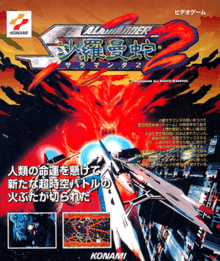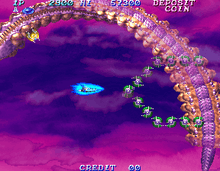Salamander 2
Salamander 2[lower-alpha 1] is a 1996 scrolling shooter arcade game developed and published in Japan by Konami. Up to two players control a starship; the Vic Viper for player one and the Super Cobra for player two; as they must destroy the alien race Doom before they wipe out all of the planet Gradius. Gameplay involves shooting down enemies, collecting power-up items, and avoiding collision with projectiles or obstacles. It is the direct sequel to Salamander (1986), a spin-off of Gradius, and the third entry in the Salamander series. It ran on the Konami GX Type 2 arcade system.
| Salamander 2 | |
|---|---|
 | |
| Developer(s) | Konami |
| Publisher(s) | Konami |
| Composer(s) | Naoki Maeda |
| Series | Salamander |
| Platform(s) | Arcade |
| Release |
|
| Genre(s) | Scrolling shooter |
| Mode(s) | Single-player, multiplayer |
| Arcade system | Konami GX Type 2 |
Gameplay

Salamander 2 is a horizontal-scrolling shooter video game, and a follow-up to Salamander (1986).[1] Up to two players control a starship that must destroy the alien race "Doom" before they destroy the planet Gradius; player one controls the Vic Viper from Gradius, while player two controls a new ship named the Super Cobra, named after an older Konami arcade game of the same name.[2] Gameplay involves shooting down incoming enemies in each stage while avoiding collision with either them, their projectiles, or the level terrain. There are six stages total; four of them are side-scrolling, while two are vertical-scrolling from an overhead view.[2] Some enemies drop power-up items when collected, which will grant either player with unique weapons and abilities; these include a forcefield, a circling "ripple laser", missiles, and small orbs known as "Options" that follow the player and fight alongside them.[3] New to this game are "Option Seeds", miniature Options that circle the player and provide additional firepower.[3] Players can also launch their Options towards enemies to create powerful, homing beam-like shots. After completing the game, it will repeat, or "loop", itself indefinitely, gradually becoming harder.[2]
Development and release
Salamander 2 was released in Japan by Konami in January 1996.[4] It is part of Konami's Salamander series, which itself is a spin-off of their Gradius series.[3] The game was developed for the Konami GX Type 2 arcade system, which also powered games such as TwinBee Yahho! and Sexy Parodius.[3][2] Mariko Tokida worked on the game's character designs and artwork, and was mostly in charge of its graphics; she recalled having difficulty with handling complex animations and the large color palette, namely with the Brain Golem boss and the asteroids in the fifth stage.[5] She also had issues with designing smaller enemies within a 16x16 size limit.[5] The music for Salamander 2 was composed by Naoki Maeda, known for his work on the Dance Dance Revolution series.[2]
In 1997, Salamander 2 was ported to the Sega Saturn and PlayStation in Japan as part of Salamander Deluxe Pack Plus, alongside ports of the original Salamander and Life Force. In 2007, it was compiled into the Japan-exclusive PlayStation Portable compilation Salamander Portable, being bundled with the original Salamander, Life Force, Xexex, and a remake of the MSX game Gradius 2, which features updated graphics and improved scrolling.[6]
Reception
| Reception | ||||||
|---|---|---|---|---|---|---|
| ||||||
In Japan, Game Machine listed Salamander 2 on their March 1, 1996 issue as being the sixth most-successful arcade game of the year.[8] The game was often criticized for its inferiority to the original, with fans feeling it lacked the "impressiveness" as Konami's other arcade and console shooters of the time.[9] Japanese video game publication Game Criticism was mostly mixed towards the game, finding it to be largely inferior to its predecessor.[9] They criticized the game for its lack of innovation, uninteresting weapon selection and off-putting graphics, specifically for their discoloration and dark tone in contrast to the bright colors the original Salamander used.[9] By contrast, Edge believed that Salamander 2 would help mark the return of more "hardcore" shoot'em up players into arcades with its challenge and graphical style.[10]
Home releases of Salamander 2 received a noticeably better reception. In his review of Salamander Deluxe Pack Plus, Rich Leadbetter of Sega Saturn Magazine praised Salamander 2 for its gameplay and visuals.[11] They also applauded the game's callbacks to the original Salamander and Life Force games and its weapons for being useful and fun to use.[11] Authors for GameFan magazine applauded the game for its graphics, gameplay and soundtrack; one said that the game "hearkens back to the glory days" of the company, and found it refreshing compared to the wave of TwinBee and Parodius games that Konami had been releasing prior.[12] Edge greatly praised its "lavishly detailed" visuals, but criticized the game for its high-difficulty and short length, writing that it was "a game which fails to offer the finely tuned balance between success and failure on which the gaming experience depends."[7]
In a 2010 retrospective review, Kurt Kalata of Hardcore Gaming 101 felt that the game lacked the innovation that Konami's other shoot'em up games at the time possessed, but said that the combination of pre-rendered and hand-drawn graphics helped give it a unique look.[2] Kalata praised the "spectacular" soundtrack, declaring it "the only noteworthy aspect of the game".[2] Retro Gamer writer Mike Bevan said that the numerous tweaks to the core gameplay made Salamander 2's gameplay fresh, and praised the game's challenge and anime-like aesthetic with its graphics.[13]
Notes
References
- "Next Wave - Protos: Arcade - Salamander 2". Electronic Gaming Monthly. No. 76. Sendai Publishing. November 1995. p. 222.
- Kalata, Kurt (25 May 2010). "Salamander 2". Hardcore Gaming 101. Archived from the original on 11 November 2019. Retrieved 12 February 2020.
- "Salamander 2 - Videogame by Konami". Killer List of Videogames. The International Arcade Museum. Archived from the original on 31 July 2017.
- Akagi, Masumi (13 October 2006). コナミ (コナミ工業) - Konami. アーケードTVゲームリスト 国内•海外編 (1971-2005) (in Japanese) (1st ed.). Amusement News Agency. p. 28. ISBN 978-4990251215.
- "1997 Salamander / Life Force Developer Memories". Shmuplations. Archived from the original on 30 December 2019. Retrieved 14 February 2020.
- Wyman, Walt (20 October 2006). "Konami preps PSP shooter comps". GameSpot. CBS Interactive. Archived from the original on 27 February 2020. Retrieved 27 February 2020.
- "Testscreen - Salamander 2" (49). Future plc. Edge. September 1997. Retrieved 14 February 2020.
- "Game Machine's Best Hit Games 25 - TVゲーム機ーソフトウェア (Video Game Software)". Game Machine (in Japanese). No. 513. Amusement Press, Inc. 1 March 1996. p. 29.
- "沙羅曼蛇2 [STG]" (in Japanese) (Volume 8). Micromagazine Co. Game Criticism. April 1996. p. 95. Retrieved 13 February 2020.
- "Arcadeview - Salamander 2" (32). United Kingdom: Future plc. Edge UK. April 1996. p. 83. Retrieved 14 February 2020.
- Leadbetter, Rich (September 1997). "Coming Soon - Salamander Deluxe Pack" (23). EMAP Images. Sega Saturn Magazine. Retrieved 12 February 2020.
- E. Storm (August 1997). "Viewpoint - Salamander Deluxe Pack" (Volume 5, Issue 8). Metropolis Media. GameFan. Retrieved 13 February 2020.
- Bevan, Mike (September 2008). "Full Of Eastern Promise - Salamander Deluxe Pack Plus" (54). United Kingdom: Future plc. Retro Gamer. pp. 58–59. Retrieved 13 February 2020.